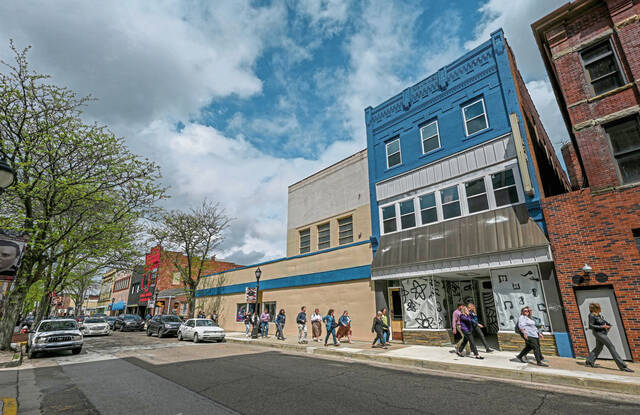An early part of redeveloping New Kensington’s downtown has focused on attracting new businesses in an effort to draw more people to the area.
The next step in revitalizing the city’s downtown will be getting more people to live there, officials say.
Mike Malcanas, owner of Olde Towne Overhaul, said his goal in focusing on New Kensington’s downtown was to “reset the heartbeat of the town.” He has bought and restored 20 abandoned buildings in the area and worked to get new businesses in them.
That work is essential to attracting new residents to the area.
“I don’t know how many people want to live downtown on top of a bunch of empty buildings with plywood and broken glass,” he said.
There are residential units above storefronts waiting to be restored.
“When is the right time for that?” Malcanas said. “At some point, we’re going to have to start testing a few of these out and see how they go.”
The possible residential future of downtown New Kensington was among the topics Malcanas and other panelists discussed this week during a workshop held by the southwest section of the American Planning Association’s Pennsylvania chapter at Voodoo Brewery New Kensington Pub, which Malcanas owns.
Other panelists were Mayor Tom Guzzo; Kevin Snider, chancellor of Penn State New Kensington; Alyssa Pistininzi, community operations manager at The Corner; Sherri McCleary, executive director of the Digital Foundry; and Jason Rigone, director of the Westmoreland County Industrial Development Corp.
It was the first in-person event the section has had since the pandemic, said Katie Stringent, a planning specialist for Moon Township. A past chair of the section, she moderated the discussion.
Section officials could not recall their workshops, held twice a year, ever being conducted in New Kensington.
It “was a good opportunity to bring together those actually involved in the resurgence of New Kensington,” said Daniel Carpenter, treasurer of the southwest section. “It’s been really remarkable to see the change occur in the city over the last few years.”
Revitalizing New Kensington hinges on collaboration, he said.
“There’s not one entity, agency or person that’s going to turn a town around,” Carpenter said. “It’s the collective efforts of a lot of players.”
Upcoming Local Events
The partnerships between and among the city, Penn State New Kensington and private developers such as Malcanas were touted as pivotal but not always easy, especially at first.
“It’s been a learning experience for all of us. This was new. At times there was frustration,” Guzzo said. “We are now in the process of figuring out ways to work together.”
Malcanas said government moves slowly, while he likes to move fast.
“We’re trying to find a middle ground,” he said.
The community was asking for help, and Snider said his campus had to get involved.
“From a selfish point of view, this is a long-term investment in the future of our campus,” he said. “The more successful this area is, the more people who move here and have babies, the more students we might get. We really felt obligated to jump in.”
Guzzo said he met Snider 15 years ago judging a spelling bee.
“We decided we needed to work together,” he said. “For him to increase enrollment, for us to increase downtown traffic, we needed each other.”
Snider said he hopes to have students living in downtown New Kensington.
Last year, the city’s planning commission recommended approval of proposed student housing in now-vacant buildings along downtown’s Fifth Avenue. That proposal hasn’t come to fruition.
While events like Fridays on Fifth, the first of which is tonight, help bring people to downtown, a lack of foot traffic at other times and on other days makes it difficult for business owners to set hours.
New developments elsewhere are being built to look like downtown New Kensington already does, with residential space over businesses, Snider said. That is a way, he said, to create foot traffic and support businesses.
There are very few people currently living in downtown New Kensington, along Fourth and Fifth avenues between Seventh and 11th streets, Guzzo said. How many could live there is not yet known.
“We just started those conversations now,” he said. “We’re going to do some studies and see what the interest is and go from there.”
Featured Local Businesses
There is concern that New Kensington’s revitalization could turn into gentrification — raising property values to the point that current residents find living there unaffordable. Citing Pittsburgh’s Lawrenceville neighborhood as an example, Malcanas said New Kensington is in the third or fourth inning of a nine-inning game, while Lawrenceville is in extra innings.
Lawrenceville underwent what many residents complained was gentrification during its revitalization in recent years. Residents complained that rent and property taxes increased so dramatically when the neighborhood became a popular destination that they could no longer afford to live there.
The New Kensington buildings Malcanas has been renovating have been empty for 30 years, so he said he doesn’t see gentrification as an issue.
“I can’t find anything bad about that,” Malcanas said. “I don’t see how that would be displacing anybody.”
Revitalization and redevelopment are fragile things, Rigone said.
“It isn’t just about the downtown. It isn’t just about jobs. It’s about so many things that have to go right,” he said. “It’s always about partnerships and making sure everybody that can bring a value and bring a resource — whether it’s the public sector, the private sector (or) the nonprofit sector — everybody plays a role.
“Revitalization, it can stop as quickly as it started, so you’ve got to be diligent.”
Brian C. Rittmeyer is a TribLive reporter covering news in New Kensington, Arnold and Plum. A Pittsburgh native and graduate of Penn State University's Schreyer Honors College, Brian has been with the Trib since December 2000. He can be reached at brittmeyer@triblive.com.


